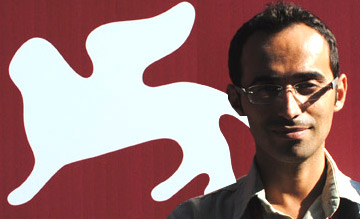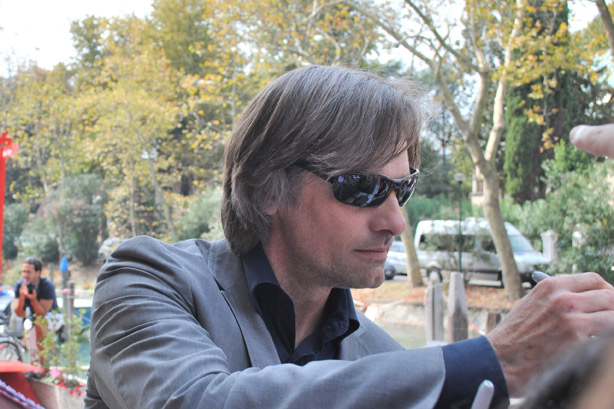 [Editors Note: We have two correspondents from Venice this year. And I feel the need to remind everyone that these opinions do not reflect the opinion of management; Nathaniel is without opinion as he is not in Venice. But he is enjoying reading these reports. Here is Ferdi from Italy, critic for, offering us bite sized opinions again. Enjoy. - Nathaniel]
[Editors Note: We have two correspondents from Venice this year. And I feel the need to remind everyone that these opinions do not reflect the opinion of management; Nathaniel is without opinion as he is not in Venice. But he is enjoying reading these reports. Here is Ferdi from Italy, critic for, offering us bite sized opinions again. Enjoy. - Nathaniel]
I love David Cronenberg unconditionally and I know from past experience that his movies are not what they seem at the very first. We have to recognize that they always need more viewings, they are so complex. A Dangerous Method is a beautifully shot period piece. It's wonderfully acted movie especially by Michael Fassbender (heartbreaking) and Viggo Mortensen (Brilliant and should be in the supporting actor race). It's about the relationship between Carl Jung, patient-psychotic Sabina Spielreinand Sigmund Freud. Cronenberg has directed period pieces before (M Butterfly, Spider, Naked Lunch) and he's not new to melodrama either (in many of his movies there's a deep melodramatic soul). The origin of psychoanalysis, which explores what is inside the body and invisible to the eye fits his radical cinematic world perfectly. Still, A Dangerous Method seems the least Cronenberg-esque of his movies. Although the score and the visuals are stunning -- lighting, sets, costumes, all gorgeous and perfect -- there's something missing here. If this frozen, crystallized surface is marvelous, maybe the inside world must be a dangerous place, crowded with demons: sexual repression, animal instinct, guilt, death, desire. And this is the place where Croneberg wants to go.
 Viggo in Venice © Fabrizio Spinetta
Viggo in Venice © Fabrizio Spinetta Fassy as shot by our correspondent Ferdi himself!
Fassy as shot by our correspondent Ferdi himself!
The first section is the best, powerful and alarming, with Keira Knightley sadistically used by Cronenberg as a shouting beast; she vomits out all her inner demons in a physical acting style that's sometimes difficult to watch. When the therapy and the love affair take root, everything begins to slow down. The narrative style normalizes and the movie changes into a beautiful restrained drama packed with visual elegance. There are still some moments blessed with the typical, disturbing Cronenberg-touch but my first impression is that the auteur could have gone further and deeper with this material.
Madonna uses the camera as a little girl who has just received a toy she wants so badly that she forgets to read the instructions. W.E., her second directorial effort, tries to emulate the flourishing visual style of Tom Ford's A Single Man (and even abuses the melodramatic violins of Abel Korzeniowski). It also too closely resembles the narrative structure of Julie & Julia insisting parallelism between two stories: the romance between King Edward VIII and Wallis Simpson and a never convincing contemporary story about a bored and depressed young woman who becomes obsessed with the American adventuress.
Let's be clear: W.E. is not a truly bad movie. Last night Un Eté Brulent by Philipp Garrell, which screened in the official selection, was much more awful. It's just that W.E. is very easy to attack. Abbie Cornish is beautiful to watch although her character is ridiculous and Andrea Riseborough is really very good as Wallis , but W.E. seems only a long commercial spot from start to finish. It's empty, superficial and naive and maybe also a little dishonest. It's all about Madonna's obsession with fashion, beauty, richness, music, and British Royals. That's it.
 [Editors Note: We have two correspondents from Venice this year. And I feel the need to remind everyone that these opinions do not reflect the opinion of management; Nathaniel is without opinion as he is not in Venice. But he is enjoying reading these reports. Here is Ferdi from Italy, critic for, offering us bite sized opinions again. Enjoy. - Nathaniel]
[Editors Note: We have two correspondents from Venice this year. And I feel the need to remind everyone that these opinions do not reflect the opinion of management; Nathaniel is without opinion as he is not in Venice. But he is enjoying reading these reports. Here is Ferdi from Italy, critic for, offering us bite sized opinions again. Enjoy. - Nathaniel] Viggo in Venice © Fabrizio Spinetta
Viggo in Venice © Fabrizio Spinetta Fassy as shot by our correspondent Ferdi himself!
Fassy as shot by our correspondent Ferdi himself!